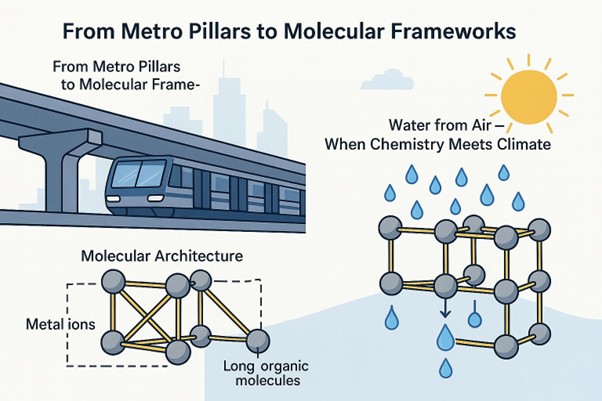The 2025 Nobel Prize in Chemistry is truly the chemistry of how scientists from three continents — Susumu Kitagawa (Kyoto University, Japan), Richard Robson (University of Melbourne, Australia), and Omar M. Yaghi (University of California, Berkeley, USA; born in Jordan) — are building on what nature gave us to shape what we now need.
As the Nobel citation reads:
“They have developed a new type of molecular architecture. In their constructions, metal ions function as cornerstones that are linked by long organic molecules…”
Let’s unpack this seemingly abstract idea into everyday themes — from atoms upward — through simple analogies like modular furniture or metro pillars that have become symbols of modern cities.
What’s New?
Earlier chemistry connected atoms to form molecules; MOF chemistry explores how molecules themselves can connect to form frameworks — ones that can even be programmed for specific outcomes.
___________________________________________________________________________________
Atomic Understanding
Everything begins with atoms — the alphabet of the universe (like the “A” of atoms).
They’re the smallest building blocks of matter.
Atoms rarely exist alone. They tend to connect — sharing or exchanging electrons — to form molecules.
That’s how water comes into being: two hydrogen atoms join with one oxygen atom to form a new molecule, H₂O.
When millions of such molecules come together, we see what we call matter — the water we drink, the air we breathe, the wood we touch.
But if atoms are alphabets and molecules are words, who decides how the sentences — the structures — are written?
___________________________________________________________________________________
Molecular Architecture
This is where the Nobel-winning phrase, “molecular architecture,” begins to make sense.
Getting back to the basics of seventh-grade science, we know that atoms combine to form molecules.
What wasn’t clear was the inability to build large, stable, porous frameworks in a predictable manner. Nature, through biological systems, has always been able to create complex, stable, and highly ordered molecular frameworks — long before humans figured out how to do it.
What the Nobel-winning scientists achieved was to design how atoms link together, for a desired outcome, just as architects plan a city, block by block.
It’s a foundational shift — the difference between finding a cave and building a house.
___________________________________________________________________________________
From Metro Pillars to Molecular Pillars
To make this idea relatable, I kept thinking about something closer to home — how our metro systems are built.
Pillars and beams are prefabricated — identical, modular, and repeatable.
When assembled precisely, they create a strong, predictable structure that carries people safely every day.
Using that same analogy, in a Metal–Organic Framework (MOF), the metal atoms are the pillars, and the organic molecules are the beams. Together, they form a repeating pattern—a molecular building with tiny, programmable pores.
That’s “architecture,” written in chemistry.
___________________________________________________________________________________
The MOF (Metal Organic Framework) Breakthrough
Here lies the real breakthrough.
MOFs made porosity designable.
Before this, porous materials like charcoal or zeolites existed in nature, but their internal connections were random.
With MOFs, scientists could decide how large each pore would be, what shape it would take, and what kind of molecule it could hold.
This Nobel award recognizes a new way of thinking — how materials themselves can be built by design.
That’s chemistry turning into engineering.
___________________________________________________________________________________
Water from Air — When Chemistry Meets Climate
One of the most striking applications of MOFs is their ability to harvest water from the air.
Even in deserts, the air holds traces of water vapor — invisible but always present.
MOFs can capture those molecules at night and, when warmed by sunlight, release them as clean water during the day.
No electricity. Just air, sunlight, and molecular design at work.
The sunlight doesn’t power the chemistry; it simply provides gentle heat—enough to release the water it holds.
It’s chemistry quietly solving a human problem — and I’m sure that, as time unfolds, we’ll see applications we can truly feel.
__________________________________________________________________________________
Beyond the Laboratory — The Larger Meaning
It isn’t only about atoms and molecules — it’s about a new way of thinking, discovering what nature gave us to designing what humanity needs, building frameworks that can store energy, capture carbon, or even draw water from the sky.
Yes, this needs a better understanding to start making sense of innovations.
This reflection is part of my personal learning journey — built through curiosity to understand complex ideas and connect to real-world meaning.
I would say, like Atoms, books are the foundation for thinking —don’t miss it.
